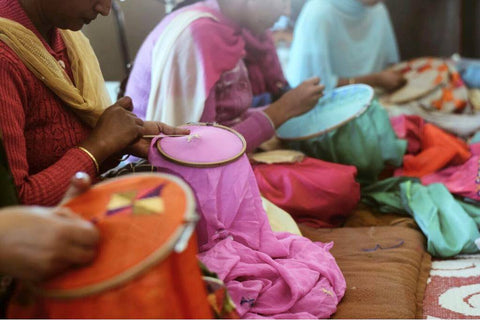The Art of Phulkari: A Stitch in Time to Save our Canines
“Not all heroes wear capes. Some of you can now adorn yourselves in the beautiful patterns of Phulkari and help save the animals.”
So why not help save animals AND look good while doing it? SevaStray has joined hands with phulkari makers of Bassi Pathana at Mehar Baba Charitable Trust (MBCT) to help thousands of stray dogs of India get a better life while empowering women of rural Punjab and bring back the ancient art of Phulkari.
Join us on our journey on why and how we are weaving a world equal for humans as well as animals.

Phulkari: Stitching Stories One Motif at a Time
India is the land of arts and crafts. Wherever one goes in the country, finding unique handicrafts and artistic forms that portray the traditional vibrancy of its culture is guaranteed. One such craft is the age-old tradition of embroidery known as Phulkari from Punjab.
Recognized as one of the most vibrant and distinctive embroidery styles in the world, Phulkari translates to working with flowers — “phul”: flower and “kari”: work. This handicraft is distinguished by its exquisite needlework, beautiful designs and motifs - especially flowers.

(Image Courtesy: Facebook; Phulkari Makers Bassi Pathana)
The art has a long and illustrious history with traces that can be found in the religious scriptures of Sikhism: Guru Granth Sahib, ancient folk songs and Vedas. Essentially phulkari was a recreational activity for women in Punjab’s households. The women of a family or community would gather together in groups called "Trijans" to enjoy their free time and indulge in this art.
Traditionally, the art was practiced to prepare head scarves and shawls known as odhni or dupatta. Khaddar, a type of coarse cotton cloth was originally the favored fabric for Phulkari. Initially, only four colors would be used as a base — red, white, blue and black. Patt, the soft untwisted silk thread dyed in yellow, white, green, red and orange were used for embroidery. The women enjoyed making phulkari and became experts at making ordinary fabrics look exquisite.
Thread by thread, each pattern was embroidered in a geometric grid. Long and short darn stitches were used to create horizontal, vertical and diagonal motifs that were inspired by everyday lives — flowers, fruits, and vegetables; birds and animals; household articles; jewelry. Thus, each piece created had a unique story and style associated with it.

(Image Courtesy: Facebook; Phulkari Makers Bassi Pathana)
The most commonly used style was bagh wherein the entire surface was embroidered. In Chope, a series of triangles were embroidered on red khaddar with yellow thread. Subhar has a central motif and four motifs on the corners. Darshan Dwar had paneled architectural motifs of pillars and gates. Chhamaas phulkari incorporated mirrors sewn in between embroidery. Sainchi is the only style where the outlines of the figures were pre-drawn and then filled by embroidering with darn stitch. Pachranga and Satranga varieties were made using five and seven different colors of threads, respectively.
Thus, each piece of phulkari created had a unique pattern and story behind it.
How Mehar Baba Charitable Trust is protecting and furthering Phulkari
Traditionally a recreational activity for Punjabi womenfolk, the art of Phulkari has gained recognition worldwide. Sadly, the art has lost its originality due to over-commercialization and machine work, leaving behind the real artisans in poverty. To fill this gap, the Indian government has formed Self Help Groups for the welfare of Phulkari artisans.

(Image Courtesy: Facebook; Phulkari Makers Bassi Pathana)
One such self-help group was started by The Mehar Baba Charitable Trust. The trust provides a six-month course in phulkari embroidery and trains about 150 women students every year. The NGO uses the empowering narrative of Phulkari as a symbol and celebration of life to encourage the women of rural Punjab to acquire new skills helping them become financially independent and self-resilient.
The Phulkari Collection at SevaStray
The streets of India are filled with an estimated 30 million stray dogs and that’s just not it! Countless cats, cows, and more animals also wander the roads of the country. Just like the gap in the preservation of our traditional arts, there has been a lack of care for the stray animals on the street.
SevaStray is devoted to helping stray animals in India by bringing you beautiful, unique, ethically sourced Indian products. Our Phulkari Collection made with love in collaboration with MBCT consists of pillow covers, stoles, shawls, scarves that allow you to contribute to empowering women, reviving ancient arts, and significantly improve the lives of stray animals.
We donate 20% of all purchases to truly amazing organizations that are working hard to improve animal welfare and make local communities safe for strays in India.